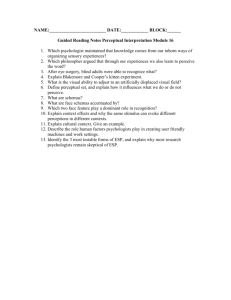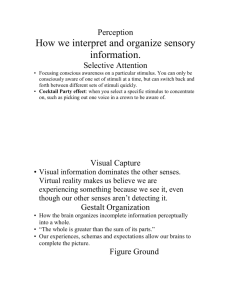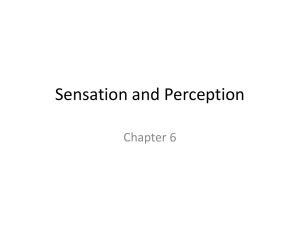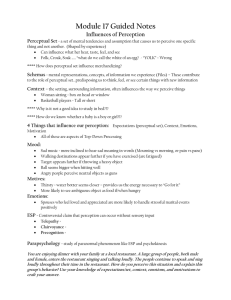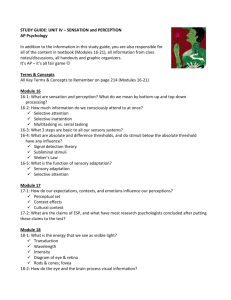Perception
advertisement
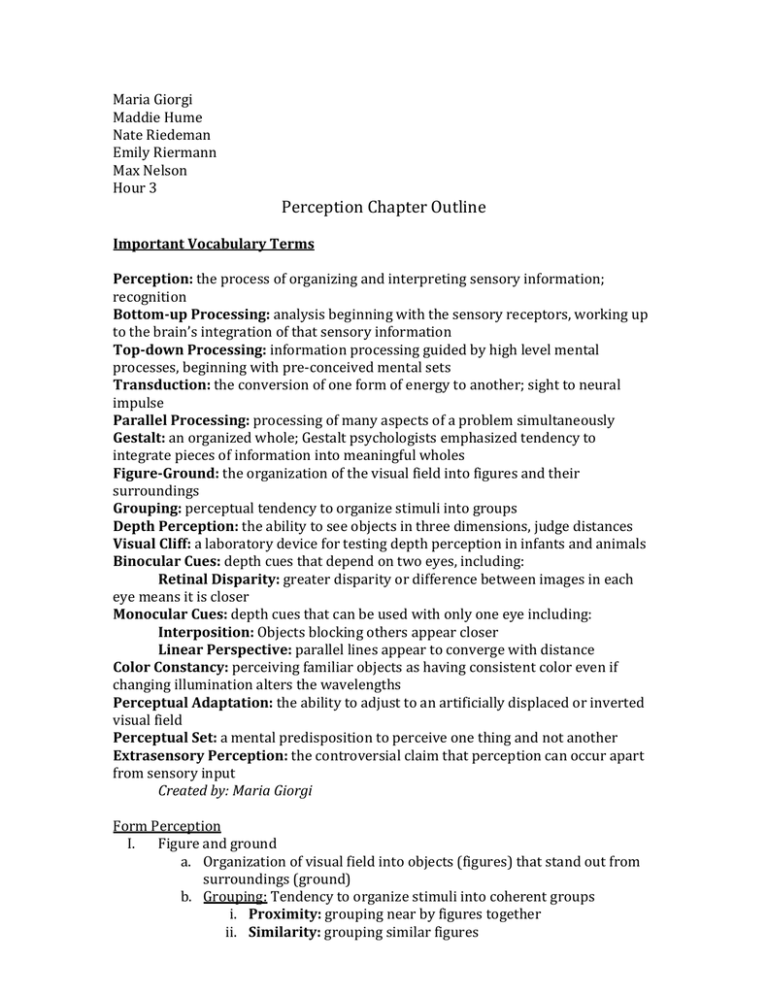
Maria Giorgi Maddie Hume Nate Riedeman Emily Riermann Max Nelson Hour 3 Perception Chapter Outline Important Vocabulary Terms Perception: the process of organizing and interpreting sensory information; recognition Bottom-up Processing: analysis beginning with the sensory receptors, working up to the brain’s integration of that sensory information Top-down Processing: information processing guided by high level mental processes, beginning with pre-conceived mental sets Transduction: the conversion of one form of energy to another; sight to neural impulse Parallel Processing: processing of many aspects of a problem simultaneously Gestalt: an organized whole; Gestalt psychologists emphasized tendency to integrate pieces of information into meaningful wholes Figure-Ground: the organization of the visual field into figures and their surroundings Grouping: perceptual tendency to organize stimuli into groups Depth Perception: the ability to see objects in three dimensions, judge distances Visual Cliff: a laboratory device for testing depth perception in infants and animals Binocular Cues: depth cues that depend on two eyes, including: Retinal Disparity: greater disparity or difference between images in each eye means it is closer Monocular Cues: depth cues that can be used with only one eye including: Interposition: Objects blocking others appear closer Linear Perspective: parallel lines appear to converge with distance Color Constancy: perceiving familiar objects as having consistent color even if changing illumination alters the wavelengths Perceptual Adaptation: the ability to adjust to an artificially displaced or inverted visual field Perceptual Set: a mental predisposition to perceive one thing and not another Extrasensory Perception: the controversial claim that perception can occur apart from sensory input Created by: Maria Giorgi Form Perception I. Figure and ground a. Organization of visual field into objects (figures) that stand out from surroundings (ground) b. Grouping: Tendency to organize stimuli into coherent groups i. Proximity: grouping near by figures together ii. Similarity: grouping similar figures iii. Continuity: tendency to perceive smooth, continuous patterns iv. Connectedness: when uniform and linked, we perceive spots, lines, areas as a single unit v. Closure: fill in gaps to create a complete, whole object Depth Perception II. Binocular cues a. Depth cues based off use of two eyes i. Retinal disparity: computing distance based on amount of difference between two images. 1. **More disparity=closer** ii. Convergence: distance based on extent to which eyes converge inward III. Monocular cues a. Distance cues available to a single eye i. Relative size: smaller images seem further away Convergence ii. Interposition: objects blocking others appear closer iii. Relative clarity: hazy objects iv. Texture gradient: further objects appear to have fine, indistinct texture. v. Relative height: objects higher in field of vision appear further away vi. Linear perspective: parallel lines appear to converge with distance vii. Light and shadow: near objects reflect more light IV. Visual Cliff Experiment a. E. J Gibson and R.D Walk b. Developed the visual cliff test to use on infants and animals to investigate when depth perception is possible c. Created by connecting a transparent glass surface to an opaque patterned surface. The floor below has the same pattern as the opaque surface making the illusion of a cliff without danger d. Results showed that infants and animals are capable of perceiving depth right away and it is not developed but instead in instinct. Created by: Maddie Hume Perceptual Set: • Perceptual set- a mental predisposition to perceive one thing and not another. • We get a perceptual set from our experiences, assumptions, and expectations. • Once we form a wrong idea about reality from our perceptual set, it is harder to see the truth about reality. Example: • Many people actually believe in the Loch Ness Monster, because of the way it was stated in the paper. • Because of their expectations, they see a "monster" and not a curved tree trunk in the water. They ignored that the object was floating motionless, without any ripples around it. Perceptual Adaptation: • Perceptual adaptation- in vision, the ability to adjust to an artificially displaced or even inverted visual field. • Humans can learn to adapt to distortion fairly easily. • Within a few minutes, a human can adjust to glasses that distort your field of view. Example: • George Stratton wore glasses that "flipped the world upside down." • At first, he had difficulty. He found difficulty eating and felt nauseated, and even had trouble walking at first. • By the eighth day, he felt as though he was completely adapted. He was able to reach for things with no problem, and walk in straight lines without bumping into things. • The world still felt topsy-turvy to him, but he had adapted. After he took off the glasses, he had no problem adapting back to his normal perceptions without distortion. Created by: Nate Riedeman Motion Perception ● Phi phenomenon- an illusion of movement created when two or more adjacent lights blink on and off in quick succession. ● Our brain constructs our perceptions ● Brain perceives continuous movement as a rapid series of varying movements. Perceptual Constancy ● Perceptual Constancy- perceiving objects as unchanging (having consistent shapes, size, lightness, and color) even as illumination and retinal images change. ● Top-down processing Shape and Size Constancies ■ Shape can seem to change from point of view/distance ■ Size constancy- perceive objects as having constant size, even if distance varies Lightness Constancy ■ Relative luminance- the amount of light an object reflects relative to its surroundings. ■ We perceive an object as having a constant lightness even while its illumination varies. Color Constancy ■ Color constancy- perceiving familiar objects as having consistent color, even if changing illumination alters the wavelengths reflected by the object. ■ Color is dependent on the light reflected by an object relative to objects around it. Perceptual Interpretation Sensory Deprivation and Restored Vision ■ Experience influences our perception of faces ■ People deprived of visual experience during childhood who gain sight later in life are better at recognizing differences in faces. Created by: Emily Riermann Parapsychology • Para = “at the side of...” Psychological phenomenon that goes beyond the main area of psychological knowledge and interest • Extrasensory perception (ESP) Form of parapsychology Is a perception of objects or events through means other than the sensory organs • Kinds of ESP Precognition The ability to know about events before they occur One of most testable and relevant kinds Psycho-kinesis The ability to make objects move by thinking of them as moving Example: levitating a table Telepathy The direct transmission of thoughts or ideas from person to person without anything being spoken or written. One of most testable and relevant kinds Clairvoyance The ability to perceive objects that are out of the range of human senses One of most testable and relevant kinds Stats Nearly ½ of all American believe humans are capable of ESP without sensory input 96% of the scientists in the U.S. National Academy of Sciences are skeptical ESP exists. Reasons why ESP is implausible Instances are just stunning coincidences • • Coincidences are more and more common with large population Not reproducible (able to have happen again and again) ● Tests of ESP ○ People’s ability to influence computer-generated random sequences of ones and zeros ■Results indicated smaller experiments reflected a person’s influence, but larger experiments did not ● By the knowledge of only one person with one true, reproducible ESP phenomenon, ESP’s existence would be proven. By Maxwell Nelson


